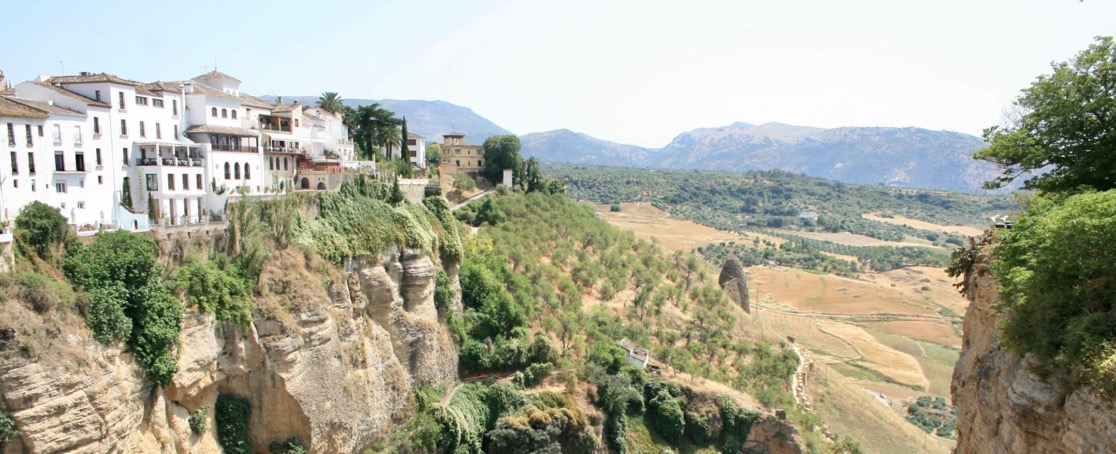Puente Nuevo
last update: 31 December 2020
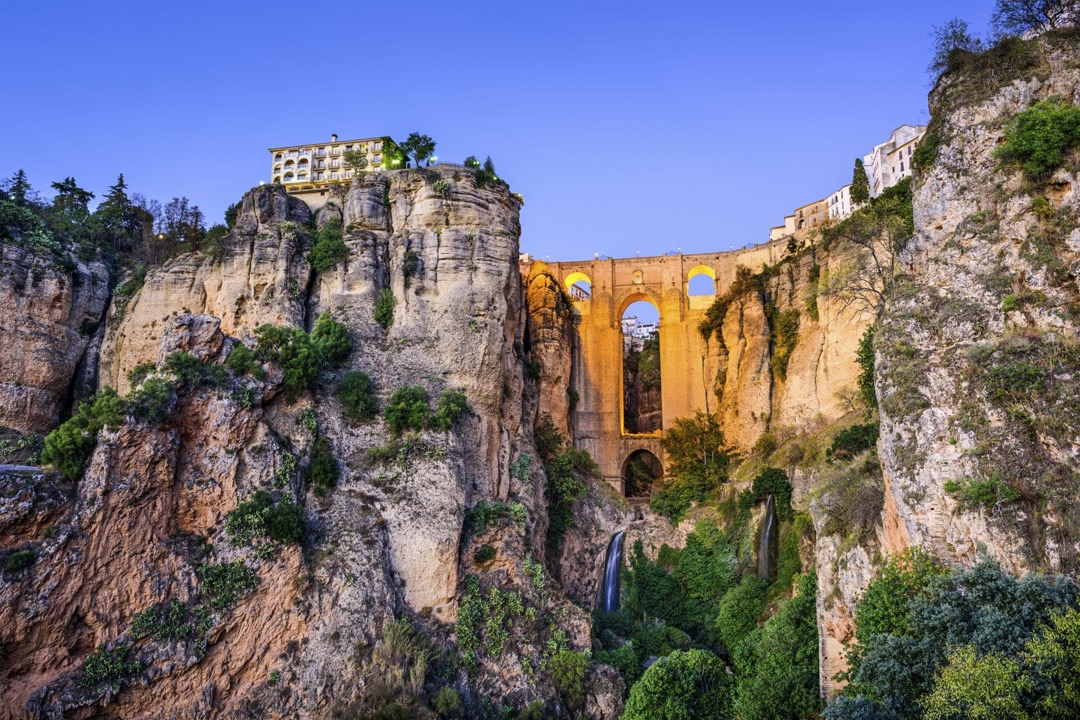
Ronda has many interesting things to see, but few are exciting. Two stand out, one is the view from the Puente Nuevo, and the other is the bullring, the Plaza de Toros.
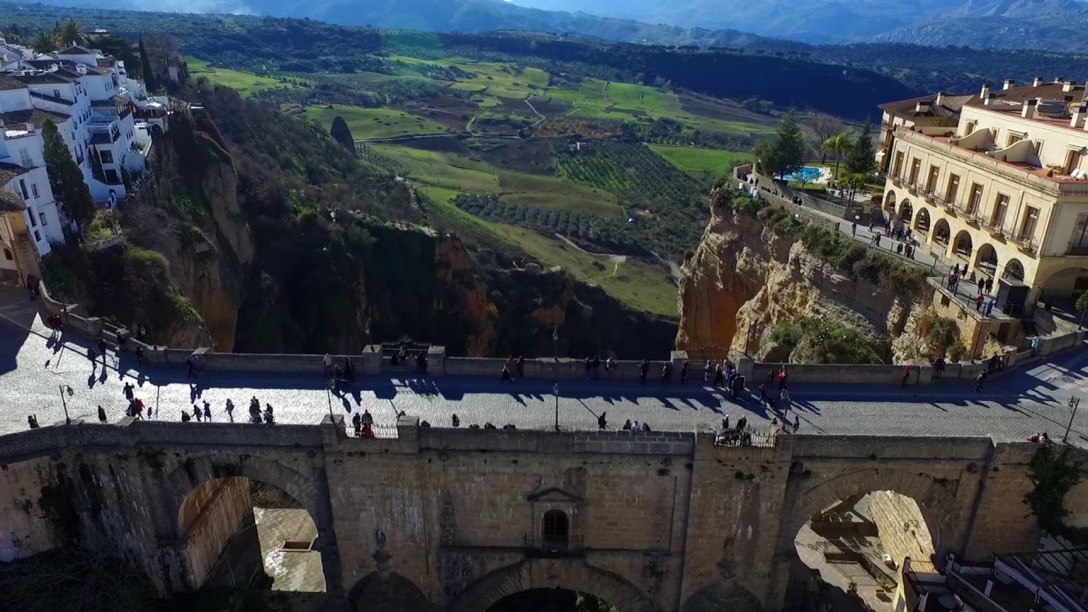
The Puente Nuevo is the symbol of Ronda, visited a million times, and it looks as if everyone who ever took a photograph of, or on, or under, the bridge has posted it on the Web. Above I've found two photographs that just looked that bit different.
Now the challenge is to also write something a 'bit different' about this impressive construction. Here goes, wish me luck.
The first Puente Nuevo
If you read around a bit you will discover that before the Puente Nuevo there was a previous puente nuevo, that fell down. But in fact the one that fell down was not the first attempt at a puente nuevo. Ronda had, at that time, the Puente de las Curtidurías (later known as the Puente Romano) and the bridge that would become known as Puente Viejo. However, according to many texts they had wanted another bridge from as early as 1542. It would appear that Puente Viejo was rebuilt a number of times, so the story goes that they only got around to finally starting on their 'new' bridge in 1735. However, that is not the whole story.
The starting point, at least in terms of bridges, was that the old Islamic fortress city sat on one side of the Tajo (gorge), and the market was outside the walls and sat on a much wider and flatter area of land on the other side of the Tajo. The Puente de las Curtidurías (bridge of the tanneries), situated near the los Baños Árabes (the Arab baths), provided the link. It was a simple bridge made of flagstones on a single, slightly pointed, brickwork arch, and certainly dating prior to the 13th century. The second bridge, currently called Puente Viejo, was the main link across the Tajo. Originally constructed in the middle of the Nasrid period, it is said to have been build on Roman remains. This second bridge was a single 10 metres wide arch set 30 metres above the river. The origins of the Mercadillo neighbourhood (market area) was simply the place where merchants installed themselves near the gate and bridge to the city. The bridge was destroyed during the Reconquista, and rebuilt in 1486, and again in 1616 after strong floods had made it unsafe. Both bridges were difficult points of access between the city and the marketplace. People had to make a wide detour on both sides and climb two slopes of more than 30°, so a third bridge was always being called for, but at a place where the two sides meet at the same hight.
The first attempt at a new bridge was probably with Francisco Gutiérrez. I think that this was the same Francisco Gutiérrez who was known as a master carpenter, and between 1697 and 1702 had worked on la Catedral de Granada. At the time he actually was imprisoned because one of his vaults had to be torn down due to shoddy workmanship.
I'm not going to try to unfold the complexities of old Spanish currencies, but it is worth knowing that a ducat was worth 16 reales. As a very rough guide a 1,000 ducats might be today about $150,000, and very roughly 1,000 reales might be about $9,000. I don't know why some figures are expressed in ducats, others in reales, and other in a mix of the two, perhaps because they were in fact different types of coins.
It was not clear if Gutiérrez's reputation was known when Ronda took him on to complete the work on la Iglesia de la Encarnación. From what I understand, the work included walls, roofing, doors and windows, but not the flooring in the main chapel. In any case Gutiérrez substantially undercut his competitors with an offer of 7,700 ducats, being much lower than the 10,000 ducats originally estimated. By 1703 a court order had been filed against Gutiérrez. He had simply started other construction projects using the material located in the church. On the other hand Gutiérrez claimed that he had not received all the material needed, specifically tiles, and that he now needed at least 12,000 reales to complete the work. His work stopped on the church in 1703 when it was decided to seize his assets and those of his guarantors. However, in 1706, the authorities were still trying to force Gutiérrez to complete his tasks, which he considered had been properly completed. But he finally did re-start the work, however his "galloping ineptitude" quickly caught up with him. The roof was leaking, and after a survey by a master builder from Sevilla, it was concluded that Gutiérrez had used poor quality materials. This master builder was paid 1,200 reales to solve the problem. Next Gutiérrez failed to mount the doors to the church, and so the authorities issued an order to seizure and sell his assets, and imprison him. Immediately the new team realised that the technical details of the building of the walls had been falsified, and that there was a real risk that they would fall down. Gutiérrez claimed that the church authorities were spending too much money based only upon theoretical knowledge, and he claimed that his work in Granada was perfect and showed that he knew what he was doing. However it was decide that Gutiérrez would have to make good the repairs to the walls, to which he refused claiming that he had already lost 10,000 ducats, and his reputation had been hurt. It would appear that the conclusion was that Gutiérrez was fined 580 reales. For those building the church, things were not so easy. Even in 1723 they were still tearing down walls and making repairs, and reports tell us that it took half a century to finish the church.
Oddly, there are also reports that already in 1700 Gutiérrez had agreed to the complete the church flooring, excluding the presbytery and pulpit, But over the following 6 years he did not lay a single slab, and could not account for the money paid to him. In 1707 he was obliged to begin work on the floor. As you might guess by now, in 1716 a different builder was contracted to finished the work, for another 37,000 reales.
It is interesting to note that Gutiérrez's effort to build a new bridge is often considered the first and original effort, but documents mention that already in 1681 Ronda had looked to 'rebuild' the bridge because it was in ruins, but the cities economy did not permit it. I do remember reading somewhere that there had been a wooden bridge, but I'm not sure where and when. There is a suggestion that an unsigned project of 1701 can be attributed to Gutiérrez, and there was mention of a stone façade with the city shield, being placed at the entrance to the Mercadillo. Also it was mentioned that parcels of land had also been allocated easing entry and exit to and from the future bridge. We know that the contract was awarded to Gutiérrez in May 1702, for a sum of 8,000 ducats. The work was to be started in 1703 and to last 2 years. However the money did not become available until 1707 and another 12,000 ducats and 4,800 reales were allocated. When the expert looked at the work of Gutiérrez on the church, he also check his work on the bridge. He found that the materials used were of quality, but the workmanship poor. He suggested getting in an expert to do the work, but accepted that Gutiérrez had already spent 47,366 reales on the work and 18,000 reales on materials. The authorities decided that Gutiérrez had only spent 13,966 reales, and they issued an order for his arrest. Gutiérrez fled, and the work was put on hold for nearly 20 years.
The second Puente Nuevo
In 1733 an attempt was made to continue the work on the bridge, but this time with Juan Antonio Camacho (1669-1740), a very well respected master builder known for his work in Córdoba. The project was modified to create a path 8 yards wide, "for greater permanence, ease, decency and usefulness". In 1736 the price was fixed at 137,800 reales, in four payments, and the guarantees were provided. The problem was that the plan was to complete the work of Gutiérrez with little or no modification to the foundations.
Paying for such a substantial investment was no easy task. The work of Gutiérrez had already amounted to 20,000 ducats, payed by an excise tax of 2,000 ducats per year. Although it must be said that some of the money had been diverted to various "national and municipal emergencies". A continuation of the tax had been agreed from 1702 to 1725 with a 1% tax on meat, a 3% tax on foreign merchandise arriving for the fairs in May, and some land leases. However, in 1721 an extension of only 6 years had been granted (and it was canceled in 1728). A 7 year extension was again requested in 1733 and agreed, except for the 1% tax on meat. However still later some of the grain in store was also being sold "for the work on the bridge".
So in 1733 the work was entrusted to Camacho, who it must be said had already worked on building bridges, e.g. the Miragenil bridge over the Genil River. Using the foundations built by Gutiérrez, the work only took 8 months. Reports say that many people, both experts and civilians, viewed the bridge, and all were very complimentary (see below for design drawn in 1811). It was a single arch going from one side to the other, and that Giralda of Seville could fit under the arch. However in 1741, the whole structure, including the trusses and timbers still in place, collapsed. Some reports claim that it occurred just before the Feria de Mayo, killing about 50 people. Other reports claim that it collapsed at around 13:00 and no one was hurt. Camacho is said to have complained that the original foundations were made with "less cost and lack of fortification".
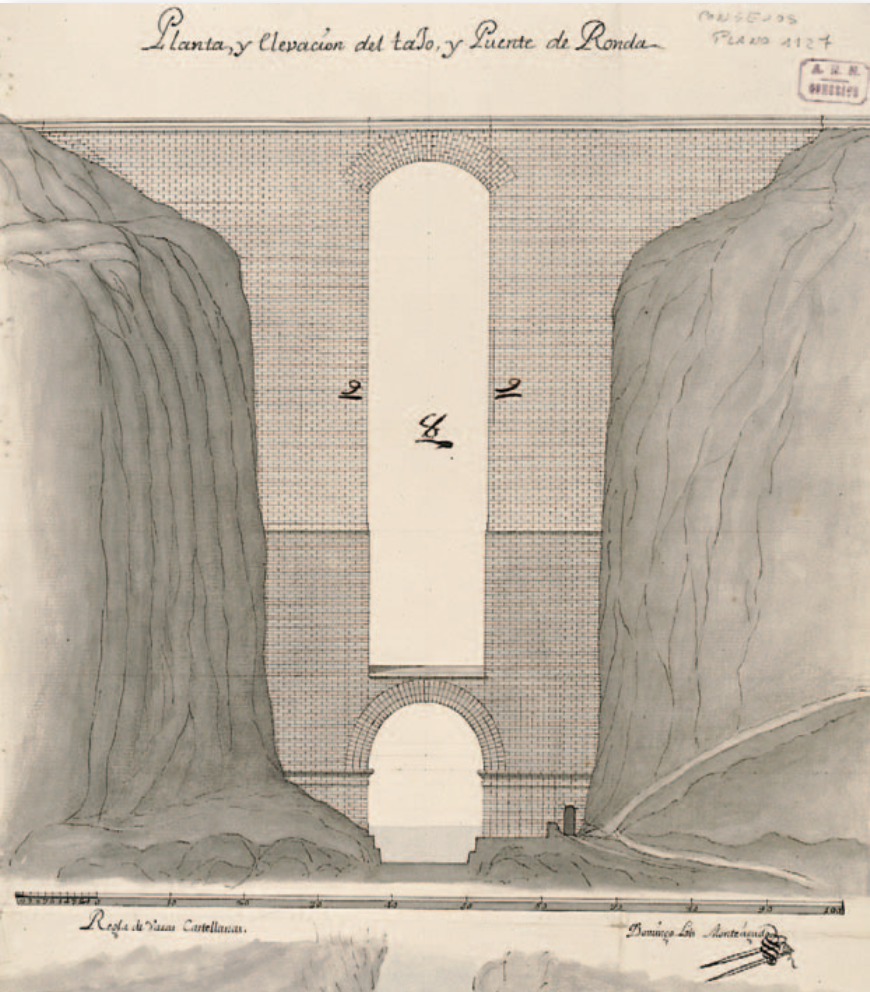
At the beginning of the 18th century Spain was in a financial crisis, which pushed everyone, including stonemasons, to contract for work on very low fix-price budgets. This forced them to work at cost and use poor quality materials. The bridge in Ronda was not the only one to collapse during construction or shortly after completion. When finally they started to rebuild the bridge again, no-one was willing to offer a fixed price, but preferring to work on a day rate. Also the arch was probably excessive for the expertise and skills of the time. The specification required two half arches of carved stones to meet in the middle and support a flat street. Remembering that architects were often master stonemasons without any formal or academic training. More formally trained architects of the time all preferred to limit the size of the arches, and build more support piers.
The city still wanted their new bridge, and they started by deciding that Camacho had not done a good job, and had even falsely declared the costs, etc. However Camacho, along with José Garcia Landaverde the master of architecture and director of the scaffolding, presented their opinion. The problem had been the poor foundations made by Gutiérrez. They proposed to build a new bridge in a safer place some 15 yards from the old site. It would have two arches and be build up from the riverbed. The city is said to have approved this plan in 1735, but the higher authorities asked for an independent expertise. The expertise occurred in 1737, and was positive, but nothing happened. In 1756 the magistrates order the city builders and carpenters to assess the plans. They concluded that most of the material from the old bridge could be reused, and that the total cost would be 100,200 reales. Now the authorities said it was urgent to have the new bridge. They had 21,812 reales from the sale of wheat, and they would recover monies from the property of the magistrate who had improperly authorised the previous bridge, and from the stonemasons who failed to complete it properly.
Camacho had received 112,109 reales, plus the value of the wood and iron provided by the city. The courts decided to recover this amount from the stonemason and his guarantors. The city did not consider the new project idea of Camacho.
The third Puente Nuevo
The city now decided to build a new bridge according to a project of a certain Gaspar Cayón, dated 1758. Cayón had been master builder of the cathedrals of Cádiz and Guadix. An inspection in 1763 concluded that his bridge (so far) was of great strength. A low arch had been built of great solidity and fixed to the floor of the gorge. This would support a narrow arch held by two massive pillars fixed to the rock walls. There was a certain Pedro Fernández in charge of the project, but, as you might expect given past experiences, the city had to approve every step. Pedro Fernández was not always present, but a certain Juan de Lara was the local surveyor on site. Fernández began by following exactly the Cayón project, but the city started to ask to find savings. Fernández presented a lighter version of the bridge, saving on materials. The idea was that the very solid base would be enough to support a lighter structure and still do the job. Pedro Fernández had been the master builder of the cathedral of Mercia, and Ronda, being on the route between Málaga and Cádiz, often saw architects and builders passing through. Along with the local stonemasons, engineers and builders, everyone agreed that the bridge would be strong enough for the task.

This is a drawing by Miguel Ángel Rocker made in 1775, showing the very solid looking lower structure completed according to the designs of Cayón.
But in 1777 everything came to a halt because one of the contributors, la Redención de Censos y Pensiones de Propios, wanted a review made. In 1778 the expert, Domingo Loys, concluded that the structure was solid, the work had progressed well, and that the plans of Pedro Fernández should be followed (Loys added new plans with some suggested enhancements). A new budget of 1.2 million reales had been estimated. But only about 15,000 reales was being collected each year, and that was not even enough to repair the ingenious, but expensive, equipment used to lower materials to the bottom of the gorge. The Ronda council then asked for a new expertise, who found the project conformed to the state-of-the-art at that time. But he did worry about the solidity of the equipment used to move materials down to the building site. So naturally the advice of another expert was requested, this time a certain Manual Godoy. This architect had worked on the cathedral of Jaén and on several bridges, and he suggested to put entrance arches to the wall buttresses, creating greater solidity, and adding a certain elegance to what looked to be a very massive structure.
The Ronda council then sent the reports and the new plans of Loys to Godoy, who replied in 1780 with a very extensive report and included new drawings as see below. The problem was that the procedures and collection of funds was slow, and finally, with ⅔ of the bridge built, they stopped the work. Despite only needing an estimated 50,000 reales to complete the work, and despite weighing up all the advantages that the new bridge would offer to the city.
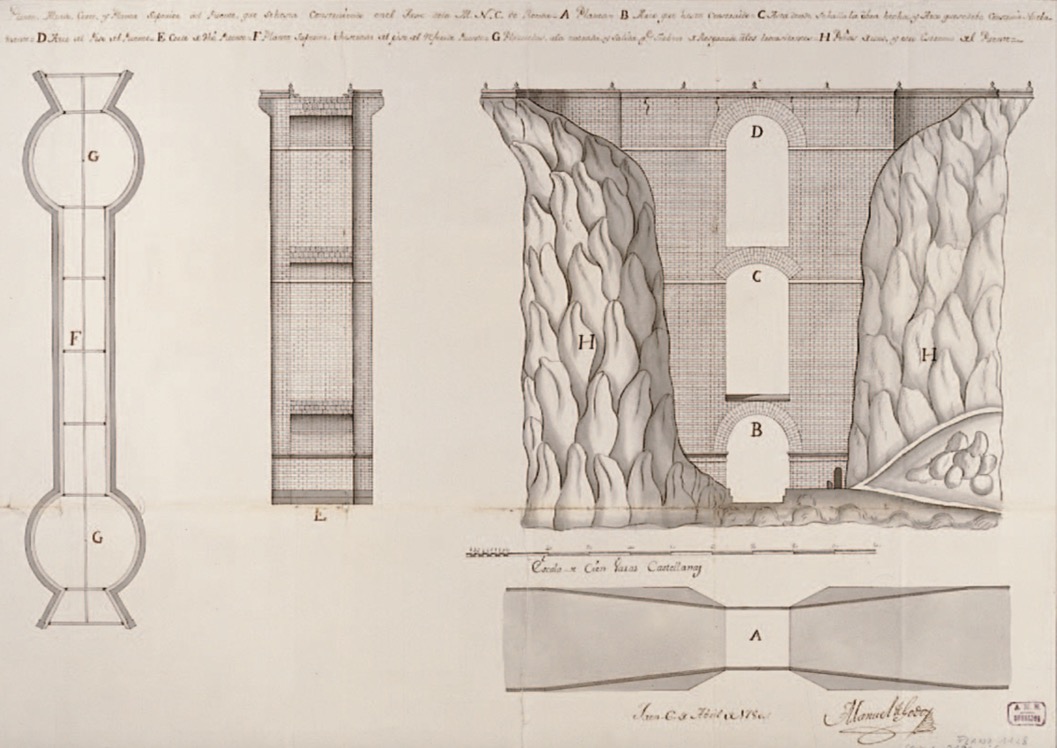
I don't know much about Godoy, except that he worked in the Neoclassical style in the second half of the 18th century, and that between 1760 and 1776 he lived and worked mostly in Valladolid, and he died in 1781 whilst still working on the Sagrario de la Catedral de Jaén.
Finally - the fourth Puente Nuevo
In 1785 it was proposed that the building project be re-started with the architect José Martín de Aldehuela, who had recently completed the Aqueduct de San Telmo in Málaga. He had already reviewed the plans, and had estimated that it would cost 1 million reales to complete the bridge. Aldehuela would direct the work, and a ship's captain Diego de Cañas y Silva would be the site manager. Many think that the bridge was completed on time thanks to the extraordinary efforts of de Cañas.
It is worth a mention as to who was José Martín de Aldehuela. He was already a well respected architect in Castile-La Mancha, but the bishop Molina Lario of Málaga knew just the project that would make him move to Andalucía. It was to direct the work of the Aqueduct de San Telmo and its flour mills, which was the most important hydraulic project in 18th century Spain. He would later also take charge of the works on the Cathedral of Málaga.
As you might expect, an architect of the status of Aldehuela would not just finished off the bridge according to existing plans. He had prepared new plans that included quite a number of modifications, thus the new budget estimate of 1 million reales. He kept the two solid buttresses and the main arch but above the arch he inserted a vaulted room enclosed by walls, and he included the two side arches. He added two terraces or balconies in the side arches that opened on the central vaulted room he had added.
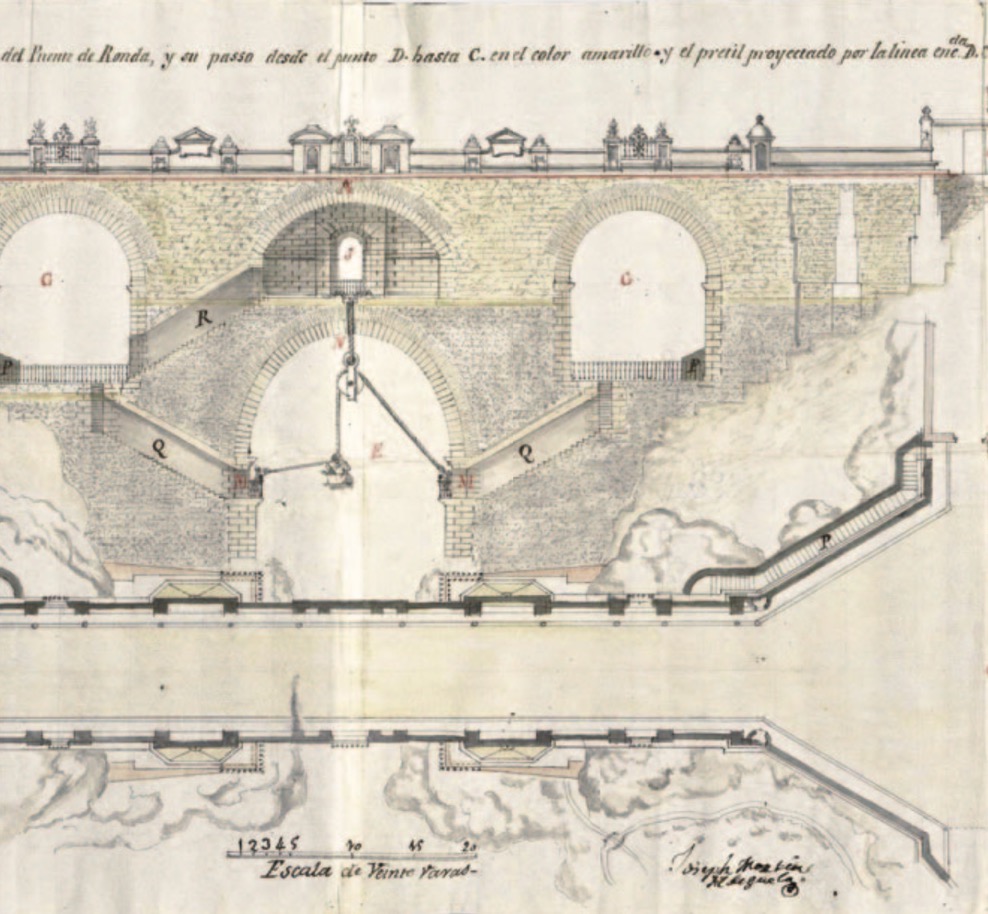
Here we can see the bridge with vaulted room the two balconies in the two side arches, and the lifting gear used to bring material down to the base of the bridge.
The large keystone in the arch was inserted in 25 August, 1786, with the usual blessing and ringing of bells, and two temporary wooden pontoons were placed over the bridge during that winter. The arch was completed on 15 September 1787, leaving the parapets, fences and ornaments to be added. However the king then saw the drawings and complained "for not being in accordance with the simplicity and seriousness required by the good order of architecture, generally adopted by the professors of greatest merit". It was thought that this referred to the high railings that were needed because it was a public walkway, so one design change was the introduction of ironwork balconies "as long as they did not deviate from the greatness of the work". In the 1790's two statues of the Reyes Católicos, leftover from the Palacio Real in Madrid, were added because they contributed "in the most recommendable way to the decoration of this distinguished work".
The first horses and carriages cross the bridge in 4 November 1787, but the bridge was finally opened to the public in 1794. Aldehuela also collaborated on the finishing of the Plaza de Toros de la Maestranza, that was under construction at the time.
The impact of the bridge was substantial, it consolidate the Mercadillo neighbourhood as the modern centre of Ronda. A large square was built next to the bridge as a food market (initial called Plaza Mayor, it's now called Plaza de España).
In 1917 there was a rockfall in the gorge, around four in the morning, that buried 15 people, 10 from the same family. They were asleep in the mills located at the bottom of the Tajo. Today those mills no longer exist.
Below we have two drawing of the bridge showing how the design gradually evolved to what we can see today.
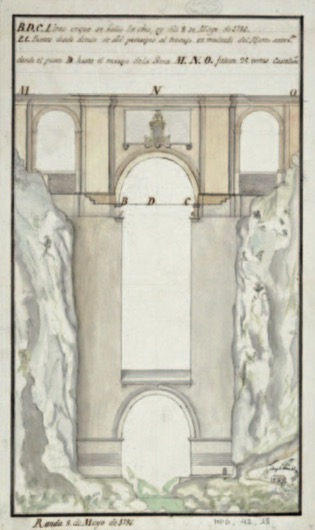
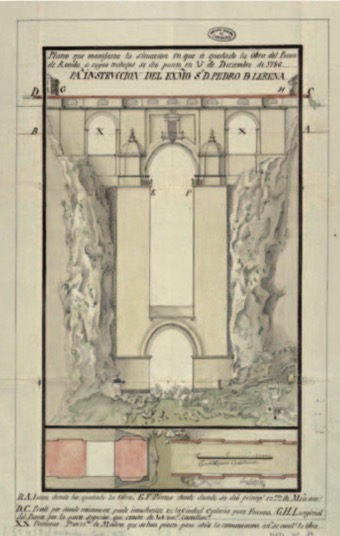
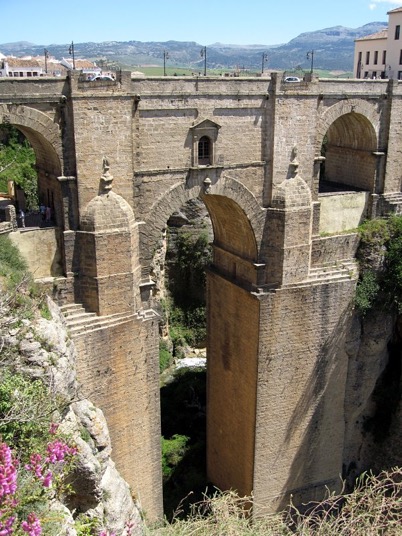
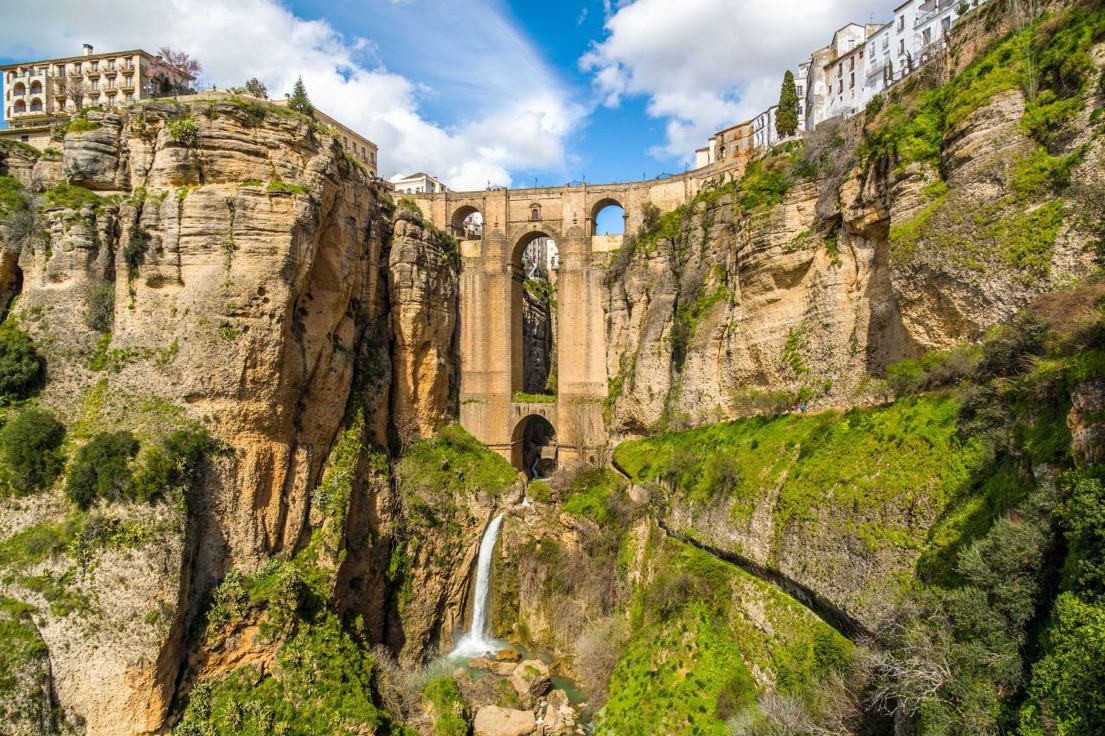
This bridge also spans the lower portion of the gorge in one arch, springing from solid buttresses that rest on the rocky bed of the torrent.
But, as the chasm widens rapidly, this first arch is merely carried sufficiently high to admit of the free passage of the stream in all seasons, and is then surmounted by a second, of the same span but much greater elevation.
The massive buttresses on either side are lightened in appearance by being pierced with arches to correspond, thus making the bridge consist of three arches above and one below.
The view from the parapet of this bridge is quite enchanting.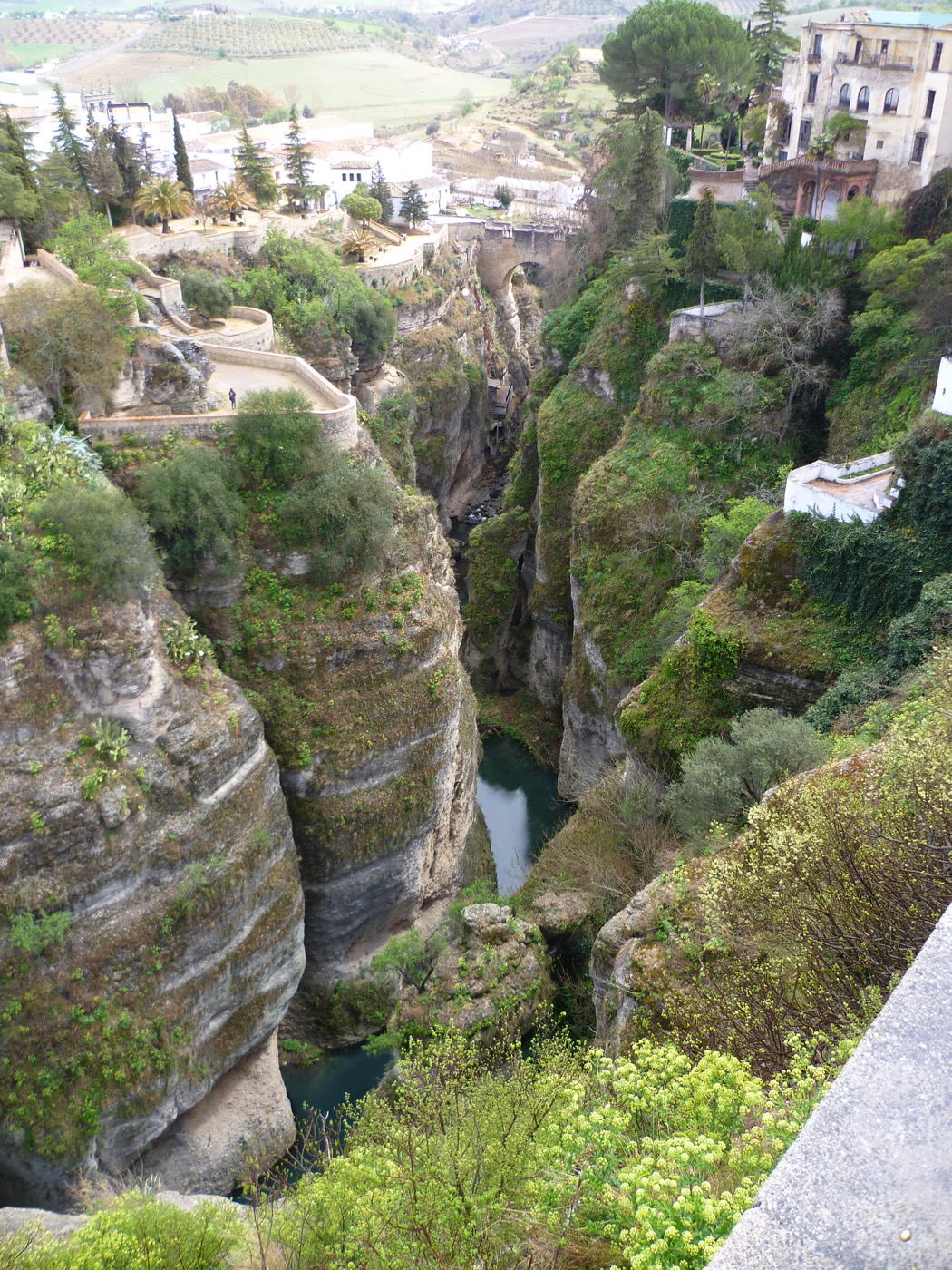
The sensation of giddiness that seizes the spectator on first leaning over the yawning abyss, leaves a feeling of pleasureable excitement, similar to that produced by a slight shock of a galvanic battery.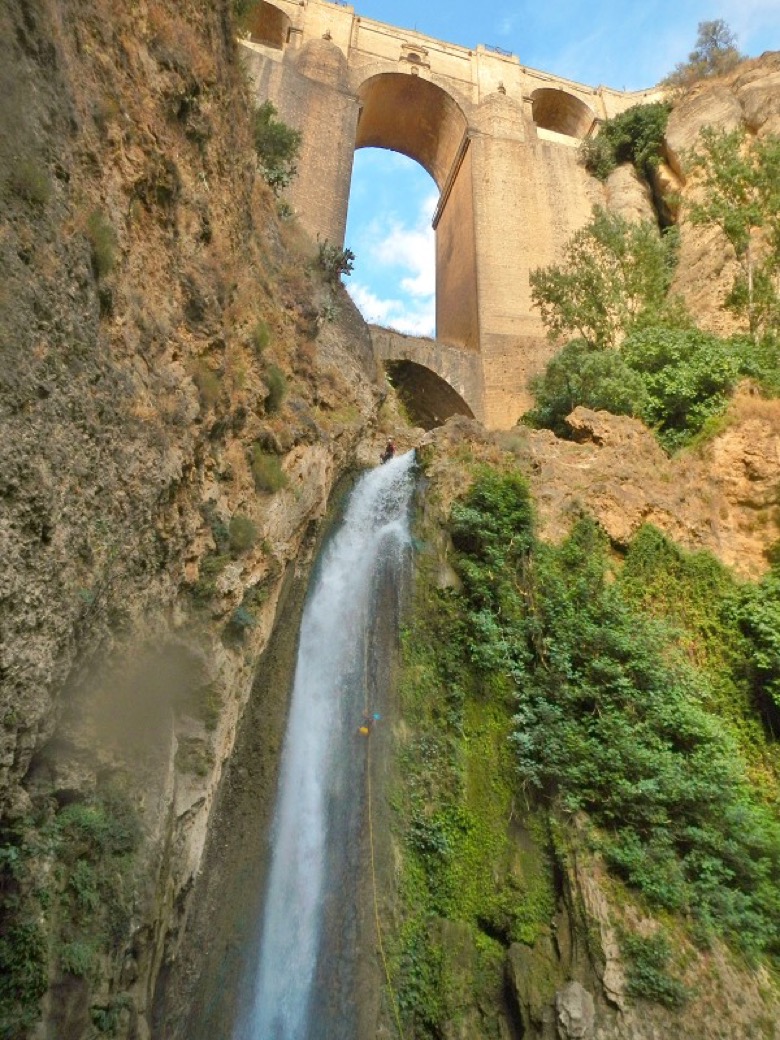
The distant roar of the foaming torrent also warns him of his perilous height, but the solid nature of the bounding wall quickly removes all feeling of insecurity, and allows him, whilst he rests against it, to enjoy at his Ieisure the noble view before him.
The view looking over the Eastern parapet of the bridge is of a more gloomy character than that from the opposite side, but is equally grand and imposing.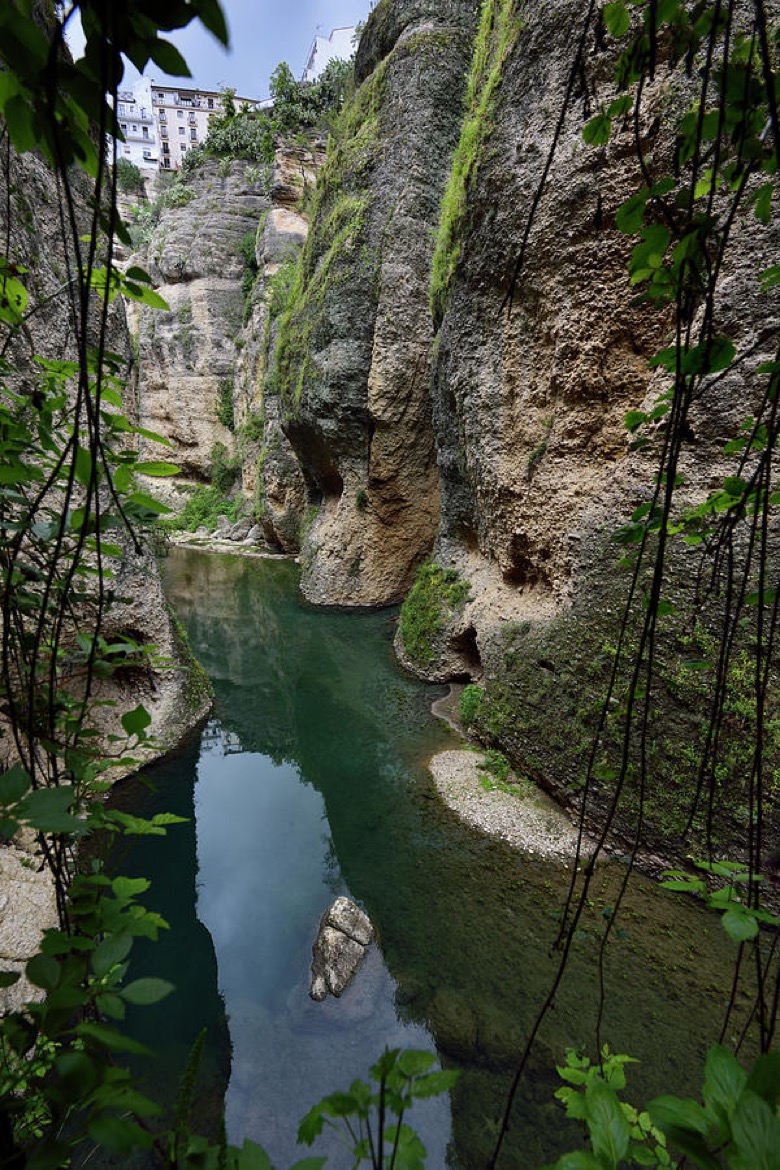
In the bottom of the dark fissure, which the sun's rays seldom reach, the transparent rivulet may be tracked, winding its way leisurely through the tortuous channel. Here and there interrupted in its course by masses of fallen rock, and partially overshadowed by trees and creepers.
Beyond the dark tajo, the sun shines on the green fields and vineyards of the fertile plain, and yet further beyond are the low wooded sierras that bound the vale of Ronda to the north.